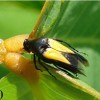Abstract
Ripiphoridae are a family of unusual parasitic beetles that are thought to be related to tumbling flower beetles and blister beetles. They parasitize bees and wasps, roaches, and wood-boring beetles, but specific hosts for many ripiphorid species are unknown. Their secretive life cycle makes an assessment of their economic and ecological impact very difficult. Additional research is necessary to determine the abundance and impact of Ripiphorus species. This 4-page fact sheet was written by David Owens, Ashley N. Mortensen, Jeanette Klopchin, William Kern, and Jamie D. Ellis, and published by the UF Department of Entomology and Nematology, December 2014.
References
Batra SWT. 1965. "Organisms associated with Lasioglossum zephyrum (Hymenoptera: Halictidae)." Journal of the Kansas Entomological Society 38: 367-389.
Buckley K, Nalen CZ, Ellis J. 2011. Halictidae (Insecta: Hymenoptera: Halictidae). EENY-499. Gainesville: University of Florida Institute of Food and Agricultural Sciences. (28 October 2014). https://doi.org/10.32473/edis-in897-2011
Eggleton P, Belshaw R. 1992. "Insect parasitoids: An evolutionary overview." Philosophical Transactions of the Royal Society of London: Biological Sciences 337: 1-20. doi: http://dx.doi.org/10.1098/rstb.1992.0079. https://doi.org/10.1098/rstb.1992.0079
Falin ZH. 2002. Ripiphoridae Gemminger and Harold 1870 (1853) pp. 431-444 in Arnett RH, Thomas MC, Skelley PE, Frank JH. American Beetles. Volume 2, Polyphaga: Scarabaeoidea through Curculionoidea. Boca Raton, FL: CRC Press.
Falin ZH, Areneson LC, Wcislo WT. 2000. "Night-flying sweat bees Megalopta genalis and M. ecuadoria (Hymenoptera: Halictidae) as hosts of the parasitoid beetle Macrosiagon gracilis (Coleoptera: Rhipiphoridae)." Journal of the Kansas Entomological Society 73: 183-185.
Linsley EG, MacSwain JW, Smith RF. 1952. "The life history and development of Rhipiphorus smithi with notes on their phylogenetic significance (Coleoptera: Rhipiphoridae)." University of California Publications in Entomology 9: 291-314.
Majka CG, Chandler DS, Sheffield CS, Webster RP. 2006. "New records of Ripiphoridae (Coleoptera) from the Maritime Provinces of Canada." The Coleopterists Bulletin 60: 299-303. doi:
https://doi.org/10.1649/0010-065X(2006)60[299:NRORCF]2.0.CO;2
Peck SB, Thomas MC. 1998. A distributional checklist of the beetles (Coleoptera) of Florida. Florida State Collection of Arthropods, Arthropods of Florida and neighboring land areas 16: 103. (28 October 2014).
Rivnay E. 1929. "Revision of the Rhipiphoridae of North and Central America (Coleoptera)." Memoirs of the American Entomological Society 6: 68.
Sikes DS. 2003. The beetle fauna of the state of Rhode Island, USA (Coleoptera): 656 new state records. Zootaxa 340: 1-38. https://doi.org/10.11646/zootaxa.340.1.1
Tomlin AD, Miller JJ. 1989. "Physical and behavioral factors governing the pattern and distribution of Rhipiphoridae (Coleoptera) attached to wings of Halictidae (Hymenoptera)." Annals of the Entomological Society of America 82: 785-791. https://doi.org/10.1093/aesa/82.6.785
Vaurie P. 1955. A review of the genus Macrosiagon in Mexico, with notes on Rhipiphorus (Coleoptera, Rhipiphoridae). American Museum of Natural History, American Museum Novitates 1717. (28 October 2014)

